#manaslutrek
Explore tagged Tumblr posts
Text
Manaslu Circuit Trek is a raw Himalayan adventure that circles Nepal’s eighth-highest peak, offering quieter trails than the popular Everest and Annapurna routes.
The journey from the lush Budhi Gandaki Valley rises through terraced hillsides, rhododendron forests, and Tibetan-style villages before cresting the dramatic 5,106-meter Larkya La pass.
Along the way, you experience vivid cultural exchanges, glacier views, and chances to spot blue sheep soaring at high altitudes.
Trip Highlights
Highlights of Manaslu Circuit Trek
Suspension-Bridge Thrills over the Budhi Gandaki: steel spans vaulting rainforest gorges and turquoise rapids, delivering dramatic first-week vistas and seamless village links.
Authentic Nubri Culture: Water-driven prayer wheels in Namrung, crimson Ribung Gompa in Lho, and yak-herding families greeting trekkers beside kilometer-long mani walls.
Syala’s 360° Sunrise Arena (3,480 m): Manaslu, Himal Chuli, and Ngadi Chuli blaze pink in one sweep of the eye, widely considered the circuit’s finest panorama.
High-Value Acclimatisation Excursions: Pungyen Gompa (4,000 m) beneath Manaslu’s south face and glacier-fed Birendra Lake offer textbook “climb high, sleep low” conditioning amid superb scenery.
Frontier Life in Samdo (3,865 m): last permanent hamlet before Tibet, famous for yak caravans, salt-for-barley trade lore, and commanding views of Samdo Peak.
The trek’s ultimate achievement is Larkya La Summit Crossing (5,106 m): Pre-dawn snowfield ascent to a prayer-flag col revealing Cheo Himal, Himlung Himal, and distant Annapurnas.
Epic Descent to Bimtang (3,590 m): One-day transition from glacial desert past Ponkar Lake to rhododendron forest and yak pastures, rewarding lungs with thicker air and trekkers with verdant sanctuary.
0 notes
Text
Manaslu Expedition Without a Guide Can Push You Beyond Your Limits
Climbing without a guide tested everything I knew about high-altitude mountaineering
The trek to Manaslu Base Camp through the Manaslu Circuit felt manageable at first. But the moment the actual climb began, the absence of a guide showed in every step.

Without a guide, I had to handle:
Daily planning and logistics
High-altitude decision-making
Gear setup, route checks, and weather assessment
Mental pressure of going solo
Equipment Alone Doesn’t Make You Safe
Above 6000 meters, every piece of gear matters. One mistake can ruin the entire climb.
I faced issues with:
Managing oxygen tanks and frozen regulators
Fixing ropes at altitude
Cooking and melting snow without help
Battery failure on GPS with no backup
A guide could have shared the load and solved issues faster.
Unpredictable Weather Becomes a Threat
I relied on downloaded forecasts, which turned outdated quickly.
When the storm came:
There was no real-time update
Visibility dropped fast
I couldn’t get reliable input on whether to continue
Retreating safely became the main goal
A guide would have read the sky better and known the safer call.
The Death Zone Doesn’t Forgive Mistakes
Above Camp IV, survival depends on oxygen and pacing. Climbing solo meant taking full responsibility in the harshest conditions.
Solo risks included:
Regulator failure with no immediate help
No one to monitor health signs
Zero backup in case of a fall or sudden illness
Difficulty in route judgment due to exhaustion
Reaching the Summit Felt Empty
Yes, I stood on the summit. But it didn’t feel like a win. I had no one to share the moment with, no celebration, no real memory beyond survival.
What was missing:
Emotional support
A steady climbing rhythm
Shared safety planning
Moments of joy and reflection
Why I Would Not Recommend Going Without a Guide
Manaslu is not a solo-friendly mountain unless you’re extremely experienced and fully supported logistically. Even then, you risk more than you gain.
A professional guide offers:
Experienced decision-making
Proper pace and acclimatization
Safety backup in case of gear failure or altitude sickness
A richer, more human connection with the mountain
Final Thought
Climbing Manaslu without a guide is not about courage. It’s about risk. Without structure, support, or shared planning, even the strongest climbers can break. If you want to reach 8000 meters and live the experience fully—not just survive it—go with someone who knows the way.
0 notes
Text
Manaslu Circuit Trek – A Remote and Rewarding Himalayan Adventure

The Manaslu Circuit Trek is a hidden gem among Nepal’s trekking routes, offering a perfect blend of raw Himalayan wilderness, cultural richness, and fewer crowds compared to the more commercial trails like Everest and Annapurna. Circling the world’s eighth-highest mountain, Mt. Manaslu (8,163m), this trek is ideal for those looking for an off-the-beaten-path experience.
Overview
The Manaslu region lies in north-central Nepal, bordering the Tibetan Plateau. Opened to trekkers in the early 1990s, the route circumnavigates Mt. Manaslu and crosses the dramatic Larkya La Pass (5,160m), one of the highest and most scenic passes in the Himalayas.
Unlike the busy trails of Annapurna or Everest, the Manaslu Circuit remains relatively untouched, preserving the authentic beauty and culture of the remote Himalayan villages.
Highlights
Majestic views of Mt. Manaslu, Himalchuli, Ngadi Chuli, and Ganesh Himal
Remote villages influenced by Tibetan Buddhism
Crossing the challenging and scenic Larkya La Pass
Rich biodiversity within the Manaslu Conservation Area
Peaceful trails with fewer trekkers
Trekking Route
The classic Manaslu Circuit trek usually starts at Soti Khola and ends at Dharapani, where it merges with the Annapurna Circuit. Here’s a standard itinerary outline:
Drive from Kathmandu to Soti Khola
Trek through Machha Khola, Jagat, Deng, and Namrung
Acclimatization in Sama Gaon
Optional side trip to Manaslu Base Camp or Pungyen Gompa
Trek to Samdo and Dharmashala
Cross Larkya La Pass and descend to Bimthang
End at Dharapani and drive to Kathmandu or Pokhara
This route typically takes 14–17 days, depending on side trips and acclimatization needs.
Difficulty and Altitude
The Manaslu Circuit is considered moderately to strenuously challenging. The trek includes long daily walks, steep ascents, and high-altitude terrain. Proper acclimatization is essential, especially before crossing Larkya La Pass.
Trekkers should be physically fit and prepared for cold weather, basic lodging, and sometimes limited amenities in the higher regions.
Permits Required
The Manaslu region is a restricted area, so you’ll need the following permits, which must be arranged through a registered trekking agency:
Manaslu Restricted Area Permit (RAP)
Manaslu Conservation Area Permit (MCAP)
Annapurna Conservation Area Permit (ACAP)
TIMS Card (in some cases, not mandatory if RAP is present)
A minimum of two trekkers is required for the restricted permit.
Best Time to Trek
The best seasons for trekking the Manaslu Circuit are:
Spring (March to May) – Blooming rhododendrons, warm days, and clear skies
Autumn (September to November) – Crisp mountain views, dry trails, and ideal weather
Winter and monsoon seasons are not recommended due to snowfall and landslides.
Accommodation and Food
The trek follows a teahouse-based system, with basic to moderate lodges available in most villages. Accommodations may be simple, especially in higher altitudes, but offer warm meals like dal bhat, pasta, soups, and Tibetan bread.
Electricity and Wi-Fi may be available in lower areas, but it’s limited at higher elevations.
Cost Estimation
The total cost varies depending on group size, trekking style, and itinerary. On average, expect to pay between $1,100 to $1,600 for a guided trek including permits, accommodation, meals, transport, and porter/guide services.
Final Thoughts
The Manaslu Circuit Trek is perfect for adventure seekers craving solitude, cultural immersion, and dramatic Himalayan scenery. Less commercialized than other classic treks, it delivers raw, unforgettable mountain experiences in one of Nepal’s most pristine regions.
0 notes
Text
Manaslu Circuit Trek – A Less Crowded Yet Stunning Adventure
The Manaslu Circuit Trek is a hidden jewel in Nepal, providing stunning scenery, various environment, and an enriching cultural experience. Compared to the Everest Base Camp Trek and the Annapurna Circuit Trek, the Manaslu Trek is less busy, making it ideal for trekkers seeking tranquility in nature. This journey takes you around Mount Manaslu (8,163m), the world’s eighth-highest peak, providing amazing views and a tough yet rewarding experience.
Why Choose the Manaslu Circuit Trek?
1. Less crowded and peaceful trails One of the most significant benefits of the Manaslu Circuit Trek is its peacefulness. While major hiking routes such as Everest and Annapurna attract hundreds of trekkers each year, Manaslu remains largely undisturbed. You can actually connect with nature and appreciate the peace and quiet of the Himalayas without the throng. 2. Breathtaking mountain views Throughout the walk, you’ll get panoramic views of Manaslu, Himalchuli, Ngadi Chuli, Ganesh Himal, and other peaks. The walk offers unrivaled splendor, with snow-capped mountains, difficult terrain, and breathtaking panoramas that change at every turn.
3. Rich Culture and Authentic Villages The Manaslu region is home to ethnic Gurung and Tibetan groups, which provide a rich cultural immersion. Ancient monasteries, chortens, and prayer flags can be seen in villages like as Soti Khola, Samagaon, and Lho, which highlight the region’s Tibetan Buddhist past. Interacting with the natives provides insight into their distinct lifestyle and traditions. 4. Larke Pass: A thrilling high-altitude experience The Manaslu Circuit Trek’s highlight is crossing the Larke Pass (5,106m), one of Nepal’s highest and most spectacular passes. It provides a tough but rewarding experience, with breathtaking views of the Himalayas and a genuine sense of accomplishment.
5. Diverse Landscapes and Unique Biodiversity The Manaslu region boasts a diverse environment, ranging from lush green woods and terraced farmland to alpine meadows and glaciers. The walk goes through the Manaslu Conservation Area, which is home to endangered species like as the snow leopard, Himalayan tahr, and red panda.
Trekking Route & Itinerary
The Manaslu Circuit Trek typically takes 14-18 days, depending on the itinerary and acclimatization needs. Here’s a standard itinerary:
Day 1-2: Kathmandu to Soti Khola (710m)
Drive from Kathmandu to Soti Khola via Arughat.
Scenic drive along rivers, hills, and villages.
Day 3-6: Trekking from Soti Khola to Namrung (2,630m)
Pass through Machha Khola, Jagat, and Deng.
Enjoy waterfalls, dense forests, and charming villages.
Day 7-9: Namrung to Samagaon (3,530m)
Explore the beautiful Lho Village and its monastery.
Acclimatization at Samagaon, visit Manaslu Base Camp or Birendra Lake.
Day 10-12: Samagaon to Dharamsala (4,460m)
Trek to Samdo and then to Dharamsala, the base before Larke Pass.
Acclimatization and rest for high-altitude trekking.
Day 13: Cross Larke Pass (5,106m) and Descend to Bhimtang (3,720m)
Challenging yet rewarding climb to Larke Pass.
Descend to the beautiful Bhimtang Valley.
Day 14-16: Trek to Dharapani and Drive to Kathmandu
Walk through lush forests and villages.
Drive from Dharapani to Kathmandu, concluding the trek.
Best Time for Manaslu Circuit Trek
The best seasons for the Manaslu Trek are:
Autumn (September – November): Clear skies, stable weather, and the best mountain views.
Spring (March – May): Blooming rhododendrons, pleasant weather, and good visibility.
Monsoon (June-August) brings heavy rainfall, making trails slippery, while winter (December-February) is extremely cold, with snow blocking high passes.
Trekking Permits & Requirements
Since the Manaslu Circuit is a restricted trekking area, you need special permits:
Manaslu Restricted Area Permit (MRAP)
Manaslu Conservation Area Permit (MCAP)
Annapurna Conservation Area Permit (ACAP) (for the exit route)
A minimum of two trekkers and a licensed guide are required to enter the restricted area.
Accommodation & Food Most tea shops along the road provide basic beds and meals. You can expect dal bhat (rice and lentils), noodles, soups, momos, Tibetan bread, and tea. Because of transportation constraints, higher elevations have fewer food options.
Difficulty Level & Preparation
The Manaslu Circuit Trek is a moderately difficult trek. It requires good physical fitness and prior trekking experience is recommended. Preparation tips:
Train with cardio, endurance, and leg exercises.
Acclimatize properly to avoid altitude sickness.
Pack essentials like warm clothing, a sleeping bag, trekking poles, and high-energy snacks.
Conclusion The Manaslu Circuit Trek offers a magnificent alternative to Nepal’s more busy hiking routes. With its breathtaking scenery, rich culture, and thrilling high-altitude adventure, it guarantees a remarkable experience for trekkers looking for both challenge and peace. The Manaslu Circuit is an excellent choice for those seeking a less commercialized but equally breathtaking Himalayan trip! Are you ready for an adventure? Start planning your Manaslu Circuit Trek now!
0 notes
Text
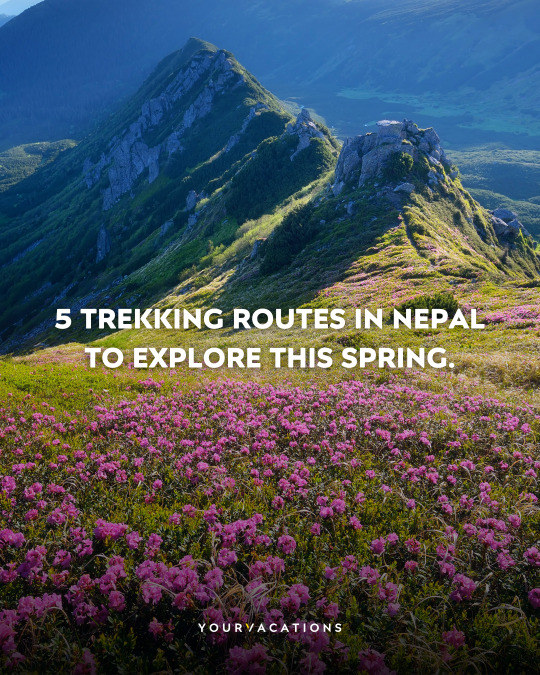
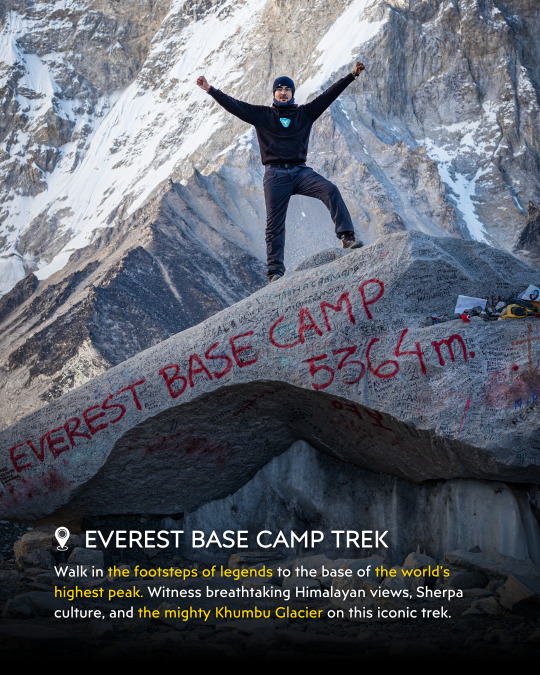
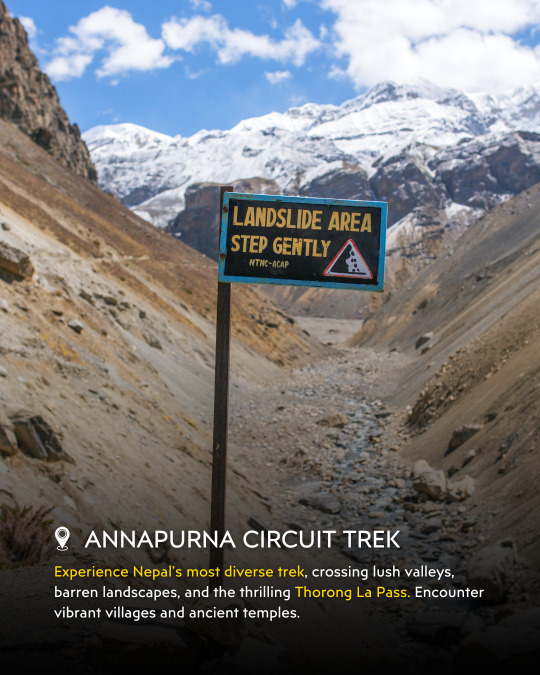
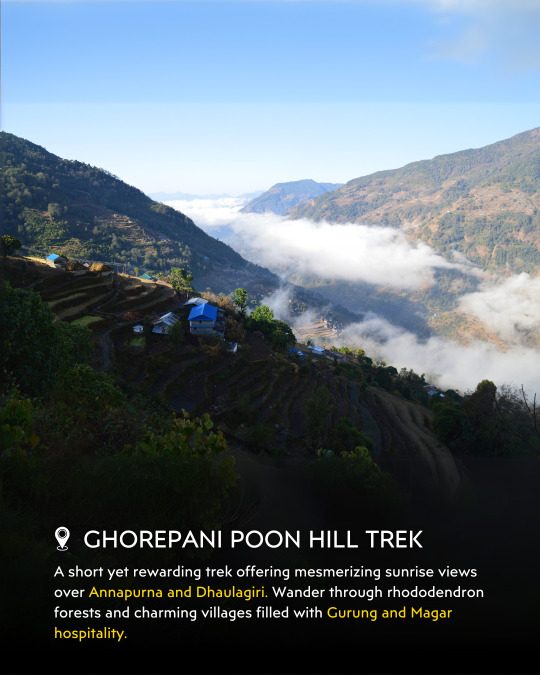
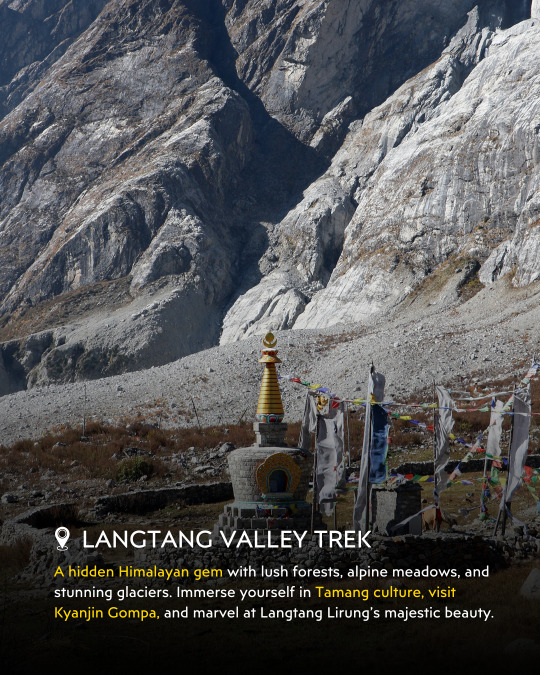
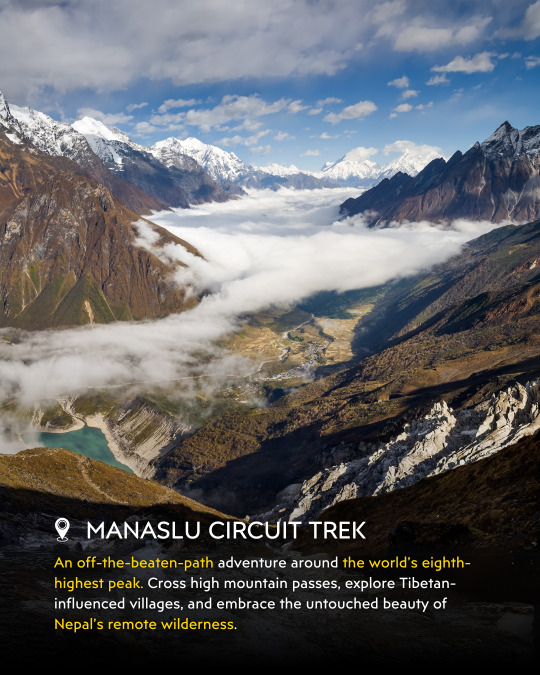
Explore Nepal’s breathtaking trekking routes this spring! Hike the Everest Base Camp for iconic mountain views, the Annapurna Circuit for diverse landscapes, or the Langtang Valley for serene beauty. Discover the hidden trails of Manaslu Circuit and the vibrant rhododendron forests of Ghorepani Poon Hill. Adventure awaits in Nepal!
#yourvacationsindia#TrekNepal#EverestBaseCamp#AnnapurnaCircuit#LangtangValley#ManasluTrek#GhorepaniPoonHill#SpringAdventure#travel#trousim#photography
0 notes
Text
Manaslu Circuit Trekking - 13 Days
Experiencing adventure in Nepal is different from having it in any other place, as the country is in the lap of the mighty Himalayas, offering several stunning and world-famous mountains to the people visiting here. Trekking is one of the activities in the country, suitable for people of almost every age group.
Manaslu Circuit Trekking is among the beautiful trekking trails, offering majestic views of Mt. Manaslu (8,163 m/26,781 ft) and some other peaks in the same mountain range, Mansiri. In addition, it provides the beautiful culture and traditions of the Tibetan Buddhists.
The trek is not so famous worldwide compared to the Everest Base Camp Trek, Annapurna Base Camp Trek, Annapurna Circuit Trek, etc. But it is also a kind of advantage for trekkers who mostly prefer off-the-beaten-path, as the routes don't get crowded even during the trekking season, allowing you to immerse in nature peacefully. However, it has recently gained popularity among the adventurers from around the world.

Where Is the Manaslu Circuit Trekking Located?
80% of the Manaslu Circuit Trek is located in the Gorkha district of Gandaki Province in the western development region of Nepal within the Manaslu Conservation Area. The remaining part is in the Manang district of the same province. However, Manang lies within the boundary of the Annapurna Conservation Area.
Manaslu Circuit Trekking Duration
The trek generally takes 13 to 14 days to complete if you begin it from Soti Khola (710 m/2329.4 ft), Gorkha, and ends in Dharapani (1,860 m/6,102.362 ft), Manang. But the duration also varies depending on your walking pace. Experienced trekkers can finish the journey even in less than the standard duration.
What Is The Best Season For Manaslu Circuit Trekking?
Regarding the best season for trekking the Manaslu Circuit, there are two seasons: spring (March-May) and autumn (September-December). Below is the breakdown of the mentioned seasons justifying why trekking during these times is the best:
During Spring
The weather is enjoyable because the temperature is often calm, with warm days and cool nights, making your travel comfortable.
All the snow also gets dissolved which makes the trail more suitable.
Colourful landscapes with rhododendrons, wildflowers, and lush greenery everywhere.
Astonishing peaks are often seeable because of the clear skies.
There is a high possibility of seeing wild animals during the trek.
Major festivals like Holi (the festival of colours), Nepali New Year, and Buddha Jayanti (the birthday of Lord Buddha) fall in spring, allowing you to celebrate with the locals.
During Autumn
The weather is usually steady due to the end of the rainy season, causing the skies to open, the trails to dry and clear, and the opportunity to shoot the panoramic views of the Himalayas and the valley's landscapes with your camera.
Dashain and Tihar, Nepal's biggest festivals, also fall this season, letting you experience the local culture and traditions.
Like spring, days and nights are warm and cool, respectively.
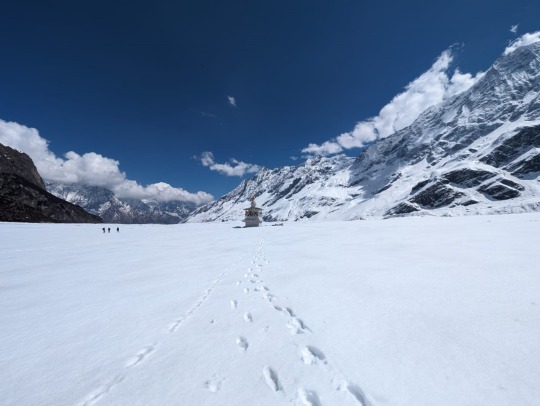
Manaslu Circuit Trekking Difficulty Level
The difficulty level of Manaslu Circuit Trekking is moderate to challenging. However, it also depends on the season. Especially during monsoon, it is all challenging.
Is It Possible To Trek The Manaslu Circuit During The Off-Season?
Yes, the Manaslu Circuit Trek during the off-season is possible. Winter (December-February) and Monsoon (June-August) are considered the off-season. Although it is possible, trekking during these months is harder than in spring and autumn, especially during the rainy season.
During monsoons, heavy rainfall is certain, causing the trail to get slippery and muddy and natural disasters like landslides and floods can occur at any time. Therefore, it isn't advisable to go for the Manaslu Trek during monsoons if you're a beginner.
Nevertheless, you can go for this trek during winter, despite freezing temperatures in the morning and night but you can stay warm by wearing winter clothes at hotels. In the daytime, the sun is usually up and bright, providing you warmth while hiking.
Manaslu Circuit Trekking Accommodation
Although the Manaslu Circuit Trek is currently underrated, there are still plenty of tea houses with modern amenities like electricity, hot showers, internet, and Western food options on the menu available along the trail. Even during the peak season, you can easily find proper accommodation.
Altitude Sickness In Manaslu Circuit Trekking
The highest elevation you'll reach in this trek is Larke Pass 5,106 m (16,752 ft) and trekking up to such height is no joke. On the other hand, altitude sickness is common once you make it up 1,800 m (5,906 ft), especially if you're from sea level.
There are three types of altitude sicknesses: Acute Mountain Sickness (AMS), High-Altitude Pulmonary Edema (HAPE), and High-Altitude Cerebral Edema (HACE). Among these three, AMS is the mild one and the other two are life-threatening if the AMS is not taken seriously.
Below are the symptoms of these sicknesses:
AMS
Headache (The most common one)
Nausea or vomiting
Insomnia or trouble sleeping
Loss of appetite
Shortness of breath
Weakness
HAPE
Severe shortness of breath
Persistent Cough
Chest tightness
Rapid heartbeat
Extreme weakness
Blue and grey discolouration of the skin, lips, and nails
Crackling sound in the chest and back while breathing
Confusion (in advanced phase)
HACE
Severe Headache
Loss of coordination
Confusion
Changes in behaviour or hallucinations
Nausea or vomiting
Seizures
Difficulty staying awake
Coma (in advanced phase)
How To Avoid Altitude Sickness?
There are several steps to avoid altitude sicknesses, such as AMS, HAPE, and HACE. They are:
Walk at a slow pace not more than 500 m per day once reaching 3,000 m above sea level.
Prioritise giving your body frequent breaks for at least 7 to 8 minutes while hiking.
Drink 2 to 3 litres of water a day and stay hydrated. Also, eat foods with high portions of water like apples and cucumbers.
Consume food that has high amounts of carbohydrates like pasta, rice, and potatoes, as they take a long time to digest, helping your body to stay energised while hiking.
Don't rush to sleep right after you arrive at the hotel to stay overnight.
Go to bed early after dinner to get enough rest.
1 note
·
View note
Text
Manaslu Circuit Trekking - 13 Days: A Complete Guide to Nepal’s Hidden Gem
The Manaslu Circuit Trek is one of Nepal’s most breathtaking yet underrated trekking routes. If you’re seeking an off-the-beaten-path adventure, away from the crowded Everest Base Camp Trek or Annapurna Circuit, the Manaslu trek is your perfect choice. This 13-day itinerary takes you through remote villages, high mountain passes, and diverse landscapes while offering stunning views of Mt. Manaslu (8,163m)—the eighth highest peak in the world.
Why Choose Manaslu Circuit Trek?
Less Crowded & Offbeat Adventure: Unlike the Annapurna and Everest regions, the Manaslu Circuit Trek remains a hidden gem.
Diverse Landscapes & Rich Culture: Experience dense forests, raging rivers, and Tibetan-influenced villages.
High Himalayan Pass - Larkya La (5,160m): One of the highest and most spectacular passes in Nepal.
Wildlife & Conservation: Trek through the Manaslu Conservation Area, home to snow leopards, Himalayan Tahr, and red pandas.
Tea House Trekking: No need for camping; cozy tea houses offer comfortable accommodation and local delicacies.
Manaslu Circuit Trek Itinerary (13 Days)

Best Time to Trek
The best seasons for the Manaslu Circuit Trek are autumn (Sep-Nov) and spring (Mar-May). These months offer stable weather, clear mountain views, and ideal trekking conditions.
Required Permits
Since the Manaslu Circuit is a restricted region, you’ll need:
Manaslu Restricted Area Permit (MRAP)
Manaslu Conservation Area Permit (MCAP)
Annapurna Conservation Area Permit (ACAP)
A licensed trekking guide is mandatory.
Packing List Essentials
Trekking boots & gear: Insulated clothing, down jacket, gloves, and hiking poles.
Sleeping bag: Suitable for sub-zero temperatures.
First Aid Kit: Includes altitude sickness medication.
Water purification tablets: For safe drinking water.
Cost of Manaslu Circuit Trek
The cost ranges from $1,200 - $1,800 per person, depending on group size, permits, and services included.
Conclusion
The Manaslu Circuit Trek offers an unforgettable journey through some of Nepal’s most untouched landscapes. With breathtaking views, authentic Himalayan culture, and a thrilling high-altitude experience, this 13-day trek is perfect for adventure lovers. If you’re looking for a trekking experience that blends beauty, challenge, and solitude, Manaslu is your next adventure!
Book your Manaslu Circuit Trek today and experience Nepal’s hidden treasure!
0 notes
Text
The answer is YES! 🙌 While the #ManasluCircuitTrekCost can vary, there are plenty of ways to make this incredible adventure affordable.
Want to know how? Check out our latest blog post for a full cost breakdown and insider tips for saving money on your trek!
0 notes
Text
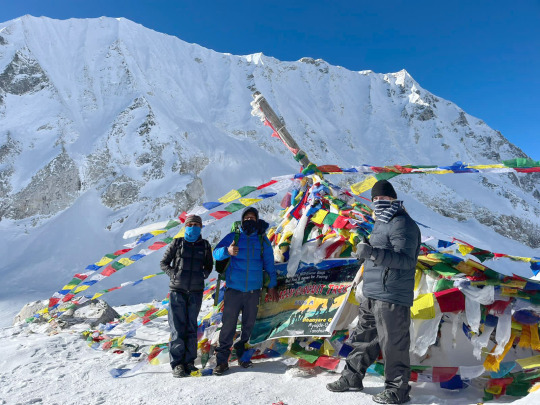
Crossing the Larkya La Pass or Larke Pass at an elevation of 5,143 meters during our Manaslu Circuit Trek. Join us for an amazing Manaslu trekking with Yoga Therapy @himalayatretas
0 notes
Text
0 notes
Text
Is the Manaslu Circuit Trek Right for You?
Nestled amidst the breathtaking landscapes of Nepal, the Manaslu Circuit Trek is a dream for many adventure enthusiasts. But is it the right choice for you? Let's break it down in simple words.

1. What's Unique About Manaslu Circuit Trek?
Manaslu Circuit Trek offers a mix of raw natural beauty and rich cultural experiences. You'll trek through unspoiled valleys, dense forests, and serene alpine landscapes, all while witnessing the majestic Mount Manaslu, the eighth highest mountain in the world.
2. Difficulty Level
On a scale from easy to challenging, Manaslu Circuit falls somewhere in the middle. If you have some trekking experience and are in good physical condition, you'll find this Manaslu trek doable. However, it's always wise to prepare with regular fitness training.
3. Duration
The trek can take anywhere from 14 to 20 days. If long journeys excite you and you have the time, this could be your next adventure. However, if you're short on time or not into lengthy treks, you might want to consider shorter options.
4. Altitude Considerations
The highest point of the trek is the Larkya La Pass, which is over 5,100 meters. Some people may experience altitude sickness. Preparing in advance and acclimatizing properly can help prevent this.
5. Cultural Experience
One of the trek's highlights is the exposure to the unique Tibetan culture in the remote villages of Nepal. If immersing yourself in different cultures is something you love, the Manaslu Circuit offers plenty of that.
6. Do You Prefer Less Crowded Routes?
Unlike the famous Annapurna or Everest Base Camp trek, Manaslu Circuit is less trodden. This means fewer crowds and a more peaceful trekking experience.
7. Permit and Cost
You'll need a special permit for Manaslu, given it's a restricted area. While this adds to the cost, it's a small price to pay for such an unparalleled experience.

In Conclusion
Manaslu Circuit Trek is a gem for those seeking a blend of adventure, culture, and nature. If you're prepared for its challenges and are drawn by its unique offerings, it might just be the perfect trek for you. However, always consider your physical capabilities, interests, and constraints before deciding. Adventure awaits, but it's essential to choose the right one for you!
#manaslucircuittrek#manaslutrek#manaslutrekking#manaslu circuit trek#nepal trekking#mount manaslu#nepal trek
0 notes
Text
The Perfect Size for Your Manaslu Circuit Trek Group: Finding the Right Balance
Embarking on the Manaslu Circuit Trek is an adventure of a lifetime that promises stunning landscapes, cultural encounters, and an opportunity to challenge oneself. As you plan this journey, one important aspect to consider is the size of your trekking group. While there's no strict rule for the minimum number of travelers required for the Manaslu Circuit Trek, finding the right balance can significantly enhance your experience. In this article, we'll explore the advantages of having an appropriate group size and provide insights into how to make the most of your trek while being eco-conscious and respectful of local communities.
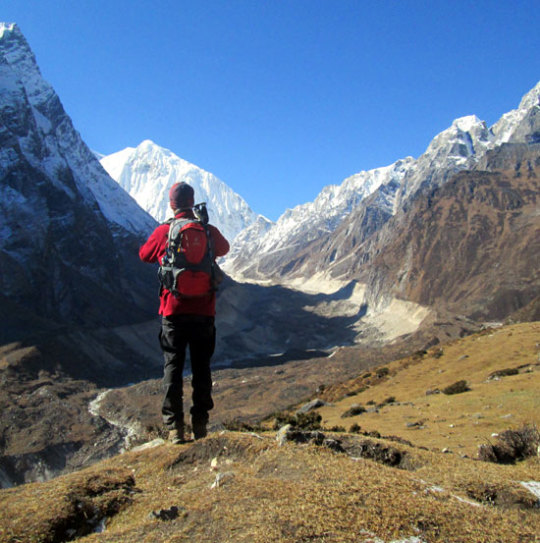
The Magic Number: Finding the Balance
The Manaslu Circuit Trek is gaining popularity due to its breathtaking views, diverse terrain, and cultural richness. When it comes to group size, there is no fixed minimum, but trekking with a group that strikes the right balance can greatly enhance your journey.
Smaller Groups, Richer Experiences
Traveling with a smaller group of trekkers—ideally 2 to 8 individuals—can offer a more intimate and immersive experience. Smaller groups allow for better interactions with locals, deeper connections with fellow trekkers, and the chance to forge lasting memories. You'll find it easier to engage in conversations with local communities, learn about their traditions, and appreciate the beauty of the region without overwhelming the environment.
Less Environmental Impact
Choosing a smaller group size contributes to a reduced environmental impact on the fragile ecosystems along the Manaslu Short Trek. Smaller groups have a lower carbon footprint, produce less waste, and exert less pressure on the local resources. By minimizing the impact on the environment, you're helping to preserve the natural beauty for future generations of trekkers to enjoy.
Cultural Sensitivity and Respect
Larger groups can sometimes inadvertently disrupt the tranquility of local villages and impact the way of life for the inhabitants. Smaller groups allow for a more harmonious coexistence with the local communities, ensuring that the cultural exchanges are meaningful and respectful. This, in turn, fosters positive relationships between travelers and locals.
Flexibility and Personalization
Smaller groups provide greater flexibility in terms of itinerary adjustments and personalized experiences. Your trek can be tailored to your preferences, pacing, and interests when you're traveling with a handful of companions. This flexibility can lead to unexpected discoveries and a more fulfilling adventure.
Tips for a Successful Trek
Choose Your Companions: Consider trekking with friends, family members, or like-minded individuals who share a passion for responsible travel and cultural exploration.
Book with Ethical Tour Operators: Opt for tour operators that prioritize sustainable and responsible trekking practices. They often promote smaller group sizes and follow Leave No Trace principles.
Plan Ahead: Make reservations well in advance to secure your spot and ensure you have a comfortable group size.
Respect Local Regulations: Abide by local guidelines and regulations that may influence group sizes and trekking protocols.
Prioritize Sustainability: Embrace eco-friendly habits during the trek, such as carrying reusable water bottles, minimizing plastic waste, and respecting wildlife.
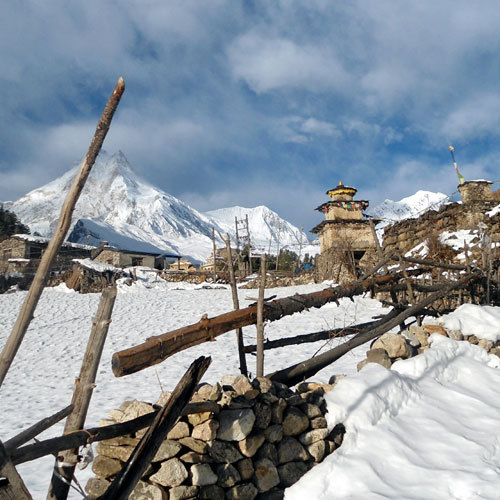
Conclusion
While there's no strict minimum number of travelers required for the Manaslu Circuit Trekking, the advantages of choosing a smaller group size are significant. From fostering meaningful interactions with locals to reducing environmental impact and enjoying a personalized experience, the benefits are abundant. Ultimately, the goal is to embark on a trek that not only leaves you with unforgettable memories but also ensures that the stunning landscapes and vibrant cultures of the Manaslu region remain intact for generations to come.
0 notes
Text
Hiring a guide for the Manaslu Circuit Trek is a wonderful choice to ensure a memorable trekking experience. A guide will help you have a hassle-free trek, making your journey more enjoyable and safer.

Hire a Guide, Porter Cum Guide and Porter cost for Manaslu Circuit Trek is:
Guide Cost US$ 30 per day, including his meals, accommodations, equipment, salary, and insurance.
Porter cum Guide cost $ 25 per day, including his meals, accommodations, equipment, salary, and insurance.
Strong porter Cost US$ 20 per day, including his meals, accommodations, equipment, salary, and insurance.
Is Posible doing Manaslu Circuit Trek without a guide?
No, it is not possible to do the Manaslu Circuit Trek without a guide. It is mandatory to have a registered guide through a registered trekking agency because the Manaslu region is a restricted area for foreign travelers. To issue the Manaslu restricted permit, you need at least two people booked through a local trekking agency. This rule is enforced by the Nepalese government for several reasons, including safety, conservation, and support for local employment.
Not only is having a guide mandatory, but this rule also helps ensure a safe and enriching experience while supporting local economies and conservation efforts. If you prefer independent trekking, consider alternative routes that allow for solo exploration only in the lower Manaslu region.
#nepal#highpassadventure#manaslucircuittrek#manaslu region#manaslutrekking#highpassadventur#nepaltrekking#trekkinginnepal#hiking adventure#travel to nepal#nepal news
4 notes
·
View notes
Text
Manaslu Trek: A Journey to Nepal’s Hidden Gem 💎
Looking for an adventure that blends stunning landscapes, rich culture, and high-altitude thrills? The Manaslu Trek offers it all! From lush forests to breathtaking mountain views, this off-the-beaten-path trek will take you through traditional villages, across suspension bridges, and up to the base of the mighty Manaslu (8,163m).
With a guide, you'll explore the beauty and culture of the region safely and make memories that last a lifetime. Ready for the challenge?
0 notes
Text

One of the most challenging trekking routes of the Himalayas, Manaslu Trekking takes you around Manaslu region in the Himalayas. The adventure offers a perfect combination of spectacular Himalayan vistas and rich biological diversity along with rich cultural riches.
#adventurehimalayacircuit#nepalhimalayastrekking#trekking#manaslutrekking#manaslutrekkingcost#manaslutrekkingitinerary#manaslutrekkingpermit#manaslutrekkingguide#travel#happy#beauty#natural#naturallover#trekkingblooger#himalayas#photography#trektomanaslu
1 note
·
View note